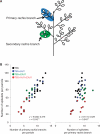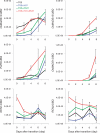Flowering time genes Heading date 1 and Early heading date 1 together control panicle development in rice
- PMID: 21565907
- PMCID: PMC3110884
- DOI: 10.1093/pcp/pcr059
Flowering time genes Heading date 1 and Early heading date 1 together control panicle development in rice
Abstract
Although flowering time is often associated with plant size, little is known about how flowering time genes affect plant architecture. We grew four rice lines having different flowering time genotypes (hd1 ehd1, hd1 Ehd1, Hd1 ehd1 and Hd1 Ehd1) under distinct photoperiod conditions. By using genotype-treatment combinations that resulted in similar flowering times, we were able to compare the effects of flowering time genes on traits related to plant architecture. The results revealed that the combination of Heading-date 1 (Hd1) and Early heading date 1 (Ehd1) can reduce the number of primary branches in a panicle, resulting in smaller spikelet numbers per panicle; this occurs independently of the control of flowering time. In addition, expression of the Hd3a and Rice Flowering-locus T 1 (RFT1) florigen genes was up-regulated in leaves of the Hd1 Ehd1 line at the time of the floral transition. We further revealed that Hd1 and/or Ehd1 caused up-regulation of Terminal Flower 1-like genes and precocious expression of panicle formation-related genes at shoot apical meristems during panicle development. Therefore, two key flowering time genes, Hd1 and Ehd1, can control panicle development in rice; this may affect crop yields in the field through florigen expression in leaf.
Figures








Similar articles
-
The Oryza sativa Regulator HDR1 Associates with the Kinase OsK4 to Control Photoperiodic Flowering.PLoS Genet. 2016 Mar 8;12(3):e1005927. doi: 10.1371/journal.pgen.1005927. eCollection 2016 Mar. PLoS Genet. 2016. PMID: 26954091 Free PMC article.
-
Diversity of floral regulatory genes of japonica rice cultivated at northern latitudes.BMC Genomics. 2014 Feb 5;15:101. doi: 10.1186/1471-2164-15-101. BMC Genomics. 2014. PMID: 24498868 Free PMC article.
-
Ehd4 encodes a novel and Oryza-genus-specific regulator of photoperiodic flowering in rice.PLoS Genet. 2013;9(2):e1003281. doi: 10.1371/journal.pgen.1003281. Epub 2013 Feb 21. PLoS Genet. 2013. PMID: 23437005 Free PMC article.
-
Research progress of photoperiod regulated genes on flowering time in rice.Yi Chuan. 2016 Jun 20;38(6):532-542. doi: 10.16288/j.yczz.15-478. Yi Chuan. 2016. PMID: 27655315 Review.
-
Transcriptional and post-transcriptional regulation of heading date in rice.New Phytol. 2021 May;230(3):943-956. doi: 10.1111/nph.17158. Epub 2021 Feb 14. New Phytol. 2021. PMID: 33341945 Free PMC article. Review.
Cited by
-
Days to heading, controlled by the heading date genes, Hd1 and DTH8, limits rice yield-related traits in Hokkaido, Japan.Breed Sci. 2020 Jun;70(3):277-282. doi: 10.1270/jsbbs.19151. Epub 2020 May 20. Breed Sci. 2020. PMID: 32714049 Free PMC article.
-
Rice panicle plasticity in Near Isogenic Lines carrying a QTL for larger panicle is genotype and environment dependent.Rice (N Y). 2016 Dec;9(1):28. doi: 10.1186/s12284-016-0101-x. Epub 2016 Jun 2. Rice (N Y). 2016. PMID: 27255512 Free PMC article.
-
Genetic analysis of an elite super-hybrid rice parent using high-density SNP markers.Rice (N Y). 2013 Aug 15;6(1):21. doi: 10.1186/1939-8433-6-21. Rice (N Y). 2013. PMID: 24279921 Free PMC article.
-
Is the time of anthesis in rice (Oryza sativa) influenced by photoperiod?Biol Futur. 2024 Dec;75(4):453-458. doi: 10.1007/s42977-024-00223-5. Epub 2024 May 14. Biol Futur. 2024. PMID: 38744795
-
Elucidation of the relationship between yield and heading date using CRISPR/Cas9 system-induced mutation in the flowering pathway across a large latitudinal gradient.Mol Breed. 2021 Mar 3;41(3):23. doi: 10.1007/s11032-021-01213-4. eCollection 2021 Mar. Mol Breed. 2021. PMID: 37309418 Free PMC article.
References
-
- Ashikari M, Sakakibara H, Lin S, Yamamoto T, Takashi T, Nishimura A, et al. Cytokinin oxidase regulates rice grain production. Science. 2005;309:741–745. - PubMed
-
- Guan JC, Jinn TL, Yeh CH, Feng SP, Chen YM, Lin CY. Characterization of the genomic structures and selective expression profiles of nine class I small heat shock protein genes clustered on two chromosomes in rice (Oryza sativa L.) Plant Mol. Biol. 2004;56:795–809. - PubMed
-
- Ikeda K, Ito M, Nagasawa N, Kyozuka J, Nagato Y. Rice ABERRANT PANICLE ORGANIZATION 1, encoding an F-box protein, regulates meristem fate. Plant J. 2007;51:1030–1040. - PubMed
Publication types
MeSH terms
Substances
LinkOut - more resources
Full Text Sources
Miscellaneous

